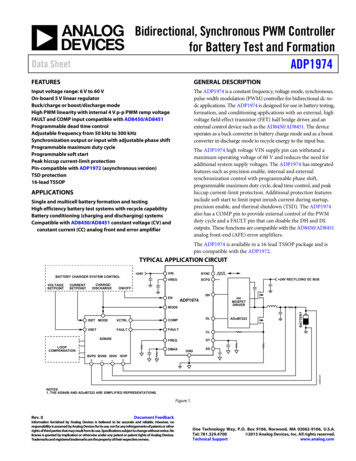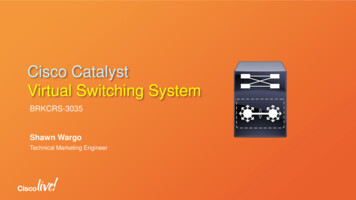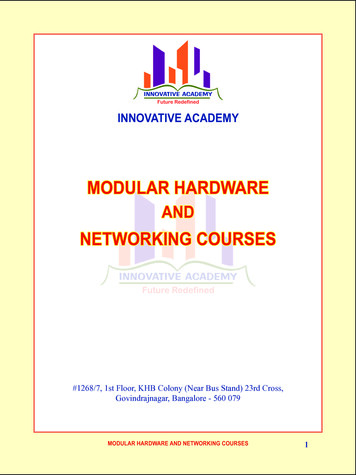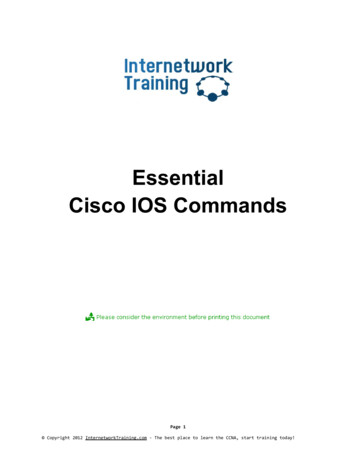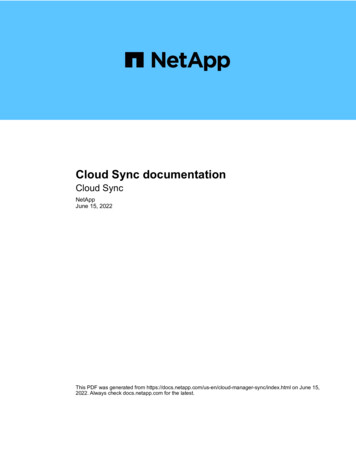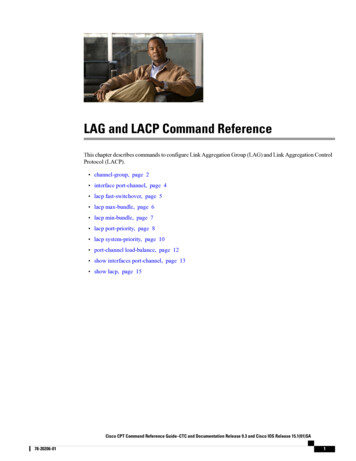
Transcription
CH A P T E R1Troubleshooting Config-Sync IssuesThis chapter describes how to identify and resolve problems that can occur with config-sync in the CiscoNexus 5000 Series switch.This chapter includes the following sections: Commit Failure Import Failure Merge Failure Switch-profile Deletion Failure Verify FailureCommit FailureUse the show switch-profile status commit command to view commit status.Commit failure has many possible causes:Note Command Parsing Failed Verify failed Commands that failed commit Another session in progressWhen a commit fails, commands that were entered under SP are still stored in the SP buffer. Do notconfigure these commands under SP again. After correcting the cause of the failure, only the commitneeds to be executed.Command Parsing FailedPossible CauseAppropriate conditional feature(s) are not enabled.SolutionEnsure that appropriate conditional feature(s) are enabled.Cisco Nexus 5500 Series Troubleshooting GuideOL-27892-011-1
Chapter 1Troubleshooting Config-Sync IssuesCommit FailureThis error message indicates that some feature commands have not been configured. Feature commandsare not allowed to be configured within SP and have to be configured on BOTH peers from conf-t.Verify failedPossible CauseThe commands listed failed mutual-exclusion checks. These commands have already been configuredunder conf-t.SolutionIf you do not want these commands synchronized, remove the commands from conf-t.Alternatively, delete these commands from the switch-profile buffer and reissue the commit.To delete commands from the switch-profile buffer, perform the following: View commands in the SP buffer using the show switch-profile buffer command. Delete commands indicated by the sequence numbers with the buffer delete range command. Use the buffer-move seq id seq id command to rearrange commands in the buffer.This is command is useful when commands in the buffer are not ordered correctly.Commands that failed commitPossible CauseCommands failed during commit.SolutionCorrect the reason for the failure and re-issue the commit.If the commit continues to fail, issue the same command from conf-t. If it succeeds from conf-t, checkfor any errors relating to the command using the show system internal csm info trace command.For every command executed from config-sync, there is a csm cmd status[0x0] line in the trace log thatindicates that the command was successful.Another session in progressPossible CauseConflict occurs if conf-t or config-sync has taken a lock.SolutionCompare the vPC domain IDs of the two switches and ensure that they match.Use the show system internal csm global info command to check whether conf-t or config-sync hastaken a lock. NoteIf conf-t has taken a lock and not released it, command output, similar to the following example, isdisplayed.The client type should be set to 2 as shown in the example.Cisco Nexus 5500 Series Troubleshooting Guide1-2OL-27892-01
Chapter 1Troubleshooting Config-Sync IssuesImport FailureExample:No of sessions: 1 (Max: 32)Total number of commands: 0 (Max: 102400)Session Database Lock Info: LockedClient: 2 (1: SSN, 2: CONF-T)Ref count: zero-based ref-countLock acquired for cmd : some-command– Identify the command that acquired the lock using the show accounting log command.– After identifying the command, check for its SUCCESS/FAILURE status.– If the command did not return a status, then config-sync would not release the lock on conf-t.– Use the test csm ssn-db-lock reset conf-t command to reset the lock. If switch-profile has taken the lock, the client id is reported as 1 in the show system internal csmglobal info command.– Use the show switch-profile status command to determine if a merge is in progress.A merge is indicated by pending merge:1 /rcvd merge:1.– If a merge/verify/commit session is already in progress, then sp ssn-db is locked.Wait for the current session to complete and try again.– If the lock is not released, use the show cfs lock command to determine if the CFS fabric islocked.Identify the application that locked CFS. If the application is session-manager, then the CFSlock was taken by config-sync.Analyze the output from the show system internal csm info trace, show cfs internalnotification log name session-mgr, and show cfs commands. Use the show system internal csm info trace command to view the events, trace, or error debugtraces.Import FailureUse the show switch-profile status command to view import status.Import failure has many possible causes: Failed to collect running-config Command does not exist in global-db Mutual exclusion check failed on peerThe following describes import options and best practices.Cisco Nexus 5500 Series Troubleshooting GuideOL-27892-011-3
Chapter 1Troubleshooting Config-Sync IssuesImport FailureTable 1-1Import OptionsTypeDescriptionimportEnables import mode. Manually enterconfiguration and then commit to move theconfiguration into SP.import running-configImports all SP-aware configurations from therunning-config into SP. Use the buffer-move andbuffer-delete commands to remove commands notto be synced and then commit the configurations.import interface interface-range Imports running configurations for specifiedinterfaces. Used to only import configurations ofinterfaces and not global configurations.import running-config exclude-phy-interfaceImports only global and logical interfaces, notphysical interface configurations.Import best practices The import option is used when the system is already configured and you want to bring in an existingconfiguration within the switch-profile and sync it with the peer. When VPC peer switches are already configured, the import operation is performed on bothswitches independently. The user must verify that the configurations are the same under SP on peerswitches and then add the sync-peer command to the configuration.If the configurations are different within the SP when the sync-peer command is added, a mergefailure occurs. Use the show switch-profile status command and determine which configurationsfailed to merge. If one of a pair of VPC switches was previously configured and the other switch was RMA’ed , thenthe switch-profile is created on both switches using the sync-peer command.This means that the configuration from the previously configured switch is imported and committedon the other switch. Also the configurations from the previously configured switch are moved fromthe global-db to the database of the switch-profile.Failed to collect running-configPossible CauseFailure occurs if the system is too busy and the show running command did not complete.SolutionDetermine if a system resource utilization problem exists. Correct the problem and retry the operation.Command does not exist in global-dbPossible CauseCommand is missing from the global-db.SolutionCisco Nexus 5500 Series Troubleshooting Guide1-4OL-27892-01
Chapter 1Troubleshooting Config-Sync IssuesMerge FailureUse the show system internal csm info global-db cmd-tbl command to determine if the commandexists in the global db. If the command exists in the global db, it is possible that there is not enough space in the show runfor the command. Ensure that there are no trailing space/tabs in show running config generation. If the command does not exist in the global db, use the show accounting log command to determineif the command was configured and to display the status of the command.– If the command status was a failure, then the command should not be displayed in show running.– If the command is displayed, then the application should correct it. If the command was configured before reload/issu, add the command back. If the accounting logshows the command’s retrieval as success, determine if the command is getting added to theglobal-db.– If the command was added correctly, copy r s, check
A merge between peers happens when a peer becomes reachable. A merge is initiated when CFS sends a peer add for the peer or if the peer is already reachable. Configuring the sync-peer command starts the merge session. Note For a merge to succeed, the configuration in the switch-profile on both peers must match exactly.
